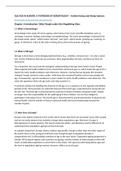OLD AGE IN EUROPE: A TEXTBOOK OF GERONTOLOGY – Kathrin Komp and Marja Aartsen
https://link-springer-com.proxy-ub.rug.nl/book/10.1007/978-94-007-6134-6
Chapter 1 Introduction: Older People under the Magnifying Glass
1.1 What is Gerontology?
Gerontology is the study of human ageing, which draws from many scientific disciplines such as
sociology, economy, biology, psychology, and epidemiology. The word ‘gerontology’ is derived from
the Greek words ‘geron’, which means ‘old man’, and ‘gerh’, which means ‘growing up, maturing, or
aging’. It, therefore, refers to the state of being old as well as the process of ageing.
1.2 What is Old Age?
Old age is more than a mere biological phenomenon (e.g., wrinkles, memory loss) – it is also a social
one. Society influences how we see ourselves, what opportunities we have, and how our lives are
structured.
For a long time, the social and the biological understanding of old age went hand in hand. People
often experienced health problems from around their retirement age on, which made the age of 65 a
marker for both, health problems and retirement. However, during the last decades this situation
changed. People started to retire earlier, while they also remained healthy until an increasingly old
age. Consequently, age 65 nowadays is a poor marker for both, health problems and retirement. This
raises the questions when old age starts and what exactly it is.
A common solution for handling the diversity of old age is as a sequence of two separate and distinct
periods of life. These periods are called the third and the fourth age, respectively the young-old and
the old–old. The third age is characterized by a period of relative freedom and good health. People
no longer have the responsibility for the upbringing of their children, nor are they obliged to
participate in the labour force. The fourth age is characterized by accelerated decline of physical and
mental health, and the number of losses in physical health and social relationships exceed the
number of gains.
1.3 How Grey is Europe?
Europe is the oldest continent in the world, which means that there we encounter many older people
and we can easily observe how societies change when populations age. Moreover, Europe is
heterogeneous in many respects. We need to look into within- and between-country differences to
understand how population ageing transforms Europe.
In a global comparison, Europe shows a distinct age-profile. Europe is older than any other region of
the world. Africa is the youngest continent. Even though Europe’s population already is
comparatively old, it will probably continue to age in the near future. Population ageing progresses in
Europe. All European regions and countries are ageing, and the number of older people in them will
reach considerable proportions in all of them in the future. The speed at which populations age and
the level of population ageing reached, however, differs across Europe.
, The different mean ages across Europe are seen in figure 1. Even though all
Figure 1
European countries deal with the phenomenon of population ageing, this
phenomenon has different levels of urgency and visibility for them. The
different shades of grey do not stop at the country level. Rather, they also
co-exist within countries, because the populations within countries do not
age homogeneously.
There are marked differences between population groups when it comes
to how fast population ageing progresses. For example, there are more
women than men in the higher age groups, and the population in rural
areas often ages faster than the population in cities. Moreover, factors
such as migration patterns and local cultures can create within-county
differences in how population ageing progresses.
Summing up, Europe is ageing and this process will continue for the
decades to come. The ageing of the European population, however, does not progress evenly. There
are marked differences between and within countries when it comes to the age-profile of Europe’s
population. We, therefore, need to have a closer look at the individual European countries and at the
different population groups
1.4 What Are Older Europeans Like?
The older European does not exist. Even though older Europeans resemble each other to some
degree, there are also marked differences between them. On the one hand, this variation is caused
by country-characteristics. Europe houses a range of political constellations, reaching from the
(former) communistic East to the liberal-democratic West, and religious orientations, reaching from
the mainly protestant North to the mainly catholic South. On the other hand, variation in Europe’s
older population is also due to differences between the individuals within a country. These individual
differences align, for example, with gender, socioeconomic status, living arrangement, marital status,
and religious affiliation.
One of the most obvious differences between older Europeans is their gender. While there are about
as many men as women in Europe, this gender-ratio is slightly different in the older age groups.
Among Europeans aged 65 years and older, we find slightly more women than men. The gender-
difference is the result of two factors. First, women live longer than men. Second, mostly men fight
as soldiers in wars, which means that war-related deaths are particularly common among men.
Another important difference between older Europeans concerns their social networks, meaning
their connections with friends and kin (Bourdieu 1986). Such connections are important for older
people, because they enhance their wellbeing and health, and they are an important source of
support in times of crisis.
A third dividing line between older Europeans is their socio-economic status. A person’s socio-
economic status describes the position he or she has in society because of wealth, educational level,
and occupational prestige. The wealth of older Europeans is comparatively high in continental
European countries such as Belgium, Switzerland, and France, and comparatively low in Eastern
European countries. The educational level is higher in Continental and Northern Europe, than in
Southern European. Older people’s occupational prestige, finally, is higher in Northern and
Continental Europe than in Southern Europe.







